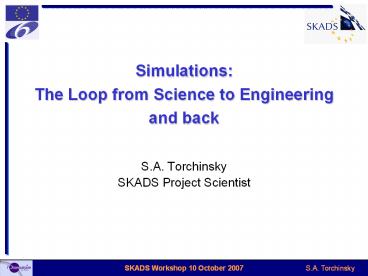Simulations: The Loop from Science to Engineering and back
1 / 29
Title:
Simulations: The Loop from Science to Engineering and back
Description:
Tests of General Relativity in extreme fields (Pulsars) ... Extrasolar planets. Extra terrestrial intelligence. S.A. Torchinsky ... –
Number of Views:19
Avg rating:3.0/5.0
Title: Simulations: The Loop from Science to Engineering and back
1
SimulationsThe Loop from Science to
Engineeringand back
- S.A. TorchinskySKADS Project Scientist
2
SKADS Science Simulations
In the context of technological constraints
3
2005 Key Science
- Pune meeting Key Science agreed
- Large Scale Structure (HI galaxy survey)
- Epoch of Reionisation
- Cosmic Magnetism
- Tests of General Relativity in extreme fields
(Pulsars) - Cradle of Life (protoplanetary disks, planets,
organic molecules)
4
SKA Science Book
Chris Carilli Steve Rawlings, New Astronomy
Reviews, Vol.48, Elsevier, Dec. 2004
http//www.skads-eu.org/p/SKA_SciBook.php
5
Strong Field Tests of Gravity
Binary orbit permits determination of masses
Relativistic effects permit (re) determination of
masses.
ALL MUST AGREE
http//www.jb.man.ac.uk/pulsar/
6
Strong Field Tests of Gravity
- Large surveys will find exotic binarys
- 20 000 pulsars in the galaxy
- Nearly edge-on Pulsar Black-hole binary (at
least one) - Probe eg. Frame dragging, no-hair theorem, cosmic
censorship - Pulsar timing array
- Gravitational wave background
7
Probing the Dark Ages
- When did the first luminous objects form?
- How did they form and over what period of time?
- SKA will detect the Epoch of Reionisation and
map the evolution history of the first luminous
objects
Furlanetto
8
Large Scale Structure
Local hydrogen
Hydrogen in a distant galaxy
Billions of galaxies!
9
BAO and Dark Energy
- Improve signal confidence by measuring wiggles in
separate redshift bins
Blake et al 2004 example assuming w-0.8, peaks
dont line up with CMB peaks (vertical lines)
10
Cosmic Shear
- Integrated gravitational lensing along
line-of-sight - weak lensing
- Requires large statistics
- SKA continuum survey of 10 Billion galaxies
- Clean sample
- Reject star burst galaxies which may be the
result of mergers(morphological alignment not
the result of cosmic shear) - Still have a large sample with SKA
- Improve result with analysis in redshift bins
- Redshifts from SKA HI survey
11
Cosmic Magnetism
- Origin of magnetic fields
- Dynamo?
- Primordial?
12
Cradle of Life
- Protoplanetary disks resolved to Earth-like
orbits - Organic molecules
- Extrasolar planets
- Extra terrestrial intelligence
13
Key Projects plus two
14
Transient signal
15
Transients
- Pulsar is a special case of transient phenomena
(periodic) - Giant pulses
- Supernova
- Bursters
- ETI
- requires
- fast time constant
- memory buffer for post analysis
- wide instantaneous, fully-sampled FoV
16
The Unknown
- New discoveries always result from observations
in new parameter space - sensitivity
- spatial resolution
- spectral resolution
- polarisation
- time domain
- observing speed (multibeaming)
- eg. CMB, pulsars, extra solar planets,
SKA improves all of these
SKA is designed for the Key Projects but with an
overriding design philosophy of flexibility to
maximise the likelihood of new discoveries
17
SKADS Science Interactions
The Universe
observations
Data analysis (DS2) science goals achievable?
Our understanding of the Universe
brain power
Request spec changeBENCHMARK
Sky Simulation (DS2T1)
Simulated telescope image
Catalogs, images, EM fields
Technology development (DS4)
Convolution with the telescope (DS2T2)
Data imaging(DS2T2)
measurementsandsimulated performance
voltages
Network simulator (DS3T3)
Technology demonstrators(DS5 DS6)
Backend data
18
SKADS Science Interactions
The Universe
SKADSDesign Costing
observations
Data analysis (DS2) science goals achievable?
Our understanding of the Universe
brain power
Request spec changeBENCHMARK
Consider trade-offs
Sky Simulation (DS2T1)
Simulated telescope image
Catalogs, images, EM fields
Technology development (DS4)
Convolution with the telescope (DS2T2)
Data imaging(DS2T2)
measurementsandsimulated performance
voltages
Network simulator (DS3T3)
Technology demonstrators(DS5 DS6)
Backend data
19
SKADS Science Simulations
- Pure sky simulations (DS2T1) feed back into
telescope simulations, configuration studies,
(DS2T2) and costing (DS3) - Key projects drive technical requirements, e.g.
- Field of view (mapping speed)
- Total Frequency range
- Instantaneous bandwidth
- Spectral resolution
- Angular resolution
- Sensitivity (Aeff/Tsys)
20
Simulations in Publications
21
Simulations for the SKA
Proceedings of the meeting held atPushchino
Radio Astronomy Observatory, Russia30 July 1
August 2007 edited by S.A. Torchinsky
22
Pushchino Meeting
- Simulations for the SKA
- 30 July to 1 August in Pushchino, Russia
- 30 participants
- Proceedings (nearly) produced
- Currently 62 pages, waiting for the last few
contributions
23
Pushchino Proceedings (1/3)
24
Pushchino Proceedings (2/3)
25
Pushchino Proceedings (3/3)
26
Science Involvement in EMBRACE
- Test and evaluation of EMBRACE
27
DS5T3 Evaluation of EMBRACE
- Demonstrate that EMBRACE can be used for
astronomical observations - Pulsar timing
- Multibeam pulsar timing
- HI mapping
- Continuum mapping
- Source tracking
- Observations in the presence of strong sources
(moon, sun) - Correlation with long baseline (Westerbork
Nançay) - Engineering/characterisation testing
- Beam profile, Tsys, Aeff, etc,
- Opportunity to have first-hand experience using
AA for astronomy - Head-start for exploiting SKA
28
SKADS Science Simulations
In the context of technological constraints
29
SKADS Webpage
www.skads-eu.org































